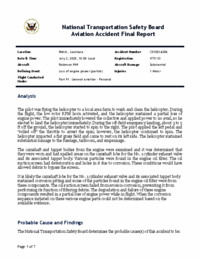
ASN Wikibase Occurrence # 238577
This information is added by users of ASN. Neither ASN nor the Flight Safety Foundation are responsible for the completeness or correctness of this information.
If you feel this information is incomplete or incorrect, you can submit corrected information.
| Date: | Thursday 2 July 2020 |
| Time: | 09:00 LT |
| Type: |  Robinson R44 Raven II |
| Owner/operator: | Direct Aerial Services, LLC |
| Registration: | N7511D |
| MSN: | 1252 |
| Year of manufacture: | 2002 |
| Total airframe hrs: | 1834 hours |
| Engine model: | Lycoming Engines O-540-F1B5 |
| Fatalities: | Fatalities: 0 / Occupants: 1 |
| Aircraft damage: | Substantial |
| Category: | Accident |
| Location: | Welsh, Jefferson Davis Parish, LA -
 United States of America United States of America
|
| Phase: | En route |
| Nature: | Private |
| Departure airport: | Welsh, LA (6R1) |
| Welsh, LA | |
| Investigating agency: | NTSB |
| Confidence Rating: |
The pilot was flying the helicopter to a local area farm to wash and clean the helicopter. During the flight, the low rotor RPM horn activated, and the helicopter sustained a partial loss of engine power. The pilot immediately lowered the collective and applied power to no avail, so he elected to land the helicopter immediately. During the off-field emergency landing, about 3 to 5 ft off the ground, the helicopter started to spin to the right. The pilot applied the left pedal and 'rolled off' the throttle to arrest the spin; however, the helicopter continued to spin. The helicopter impacted a flat grass field and came to rest on its left side. The helicopter sustained substantial damage to the fuselage, tailboom, and empennage.
The camshaft and tappet bodies from the engine were examined and it was determined that they were worn and had spalled areas on the camshaft lobe for the No. 1 cylinder exhaust valve and its associated tappet body. Various particles were found in the engine oil filter. The oil suction screen had deterioration and holes in it due to corrosion. These conditions would have allowed debris to bypass the screen.
It is likely the camshaft lobe for the No. 1 cylinder exhaust valve and its associated tappet body sustained corrosion pitting and some of the particles found in the engine oil filter were from these components. The oil suction screen failed from erosion-corrosion, preventing it from performing its function of filtering debris. The degradation and failure of these engine components resulted in a partial loss of engine power while in flight. When the corrosion sequence initiated on these various engine parts could not be determined based on the available evidence.
Probable Cause: A partial loss of engine power while in flight due to corrosion of engine components, which resulted in a loss of control and a subsequent impact with terrain.
Accident investigation:
 |
|
Sources:
NTSB CEN20LA286
Location
Revision history:
| Date/time | Contributor | Updates |
|---|---|---|
| 24-Jul-2020 20:40 | Captain Adam | Added |
| 26-Aug-2020 08:19 | ASN Update Bot | Updated [Time, Cn, Operator, Departure airport, Source, Narrative] |
| 01-Jul-2022 09:07 | ASN Update Bot | Updated [Time, Operator, Other fatalities, Destination airport, Source, Narrative, Category, Accident report] |
| 01-Jul-2022 09:08 | harro | Updated [Phase, Narrative] |
Corrections or additions? ... Edit this accident description
The Aviation Safety Network is an exclusive service provided by:


 ©2024 Flight Safety Foundation
©2024 Flight Safety Foundation